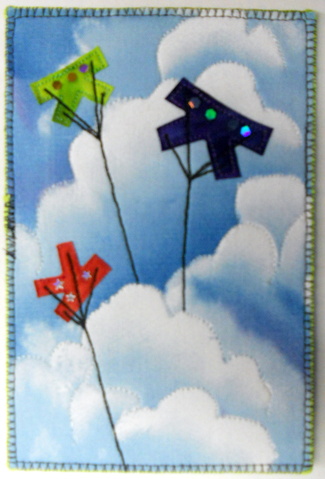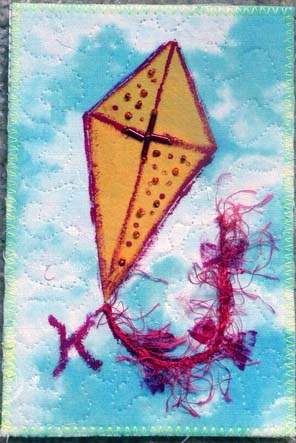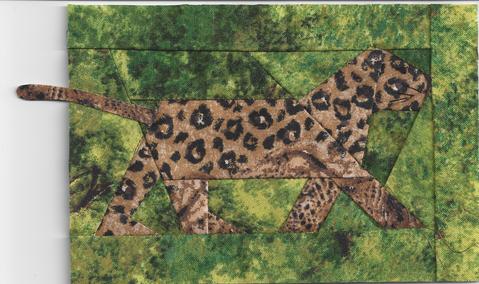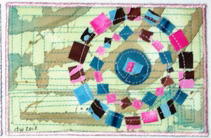This month we are traveling to Friday Harbor, Washington, to visit Marie Johansen.
Do you call it a studio or sewing room?
I do have a “studio room” that is in the eaves of our house, but I cannot stand upright in it. Since having two major back surgeries in 2010 I have not been as agile going up and down the ladder that gets me there and so my new ‘studio’ has become a large table in the living room.
It’s not really very adequate, but it is what is at the moment. My dream, of course, would be to have a room, where I could can organize everything, and could actually stand up in! My fabrics are all still contained “up the ladder” while all of more mixed media and fiber supplies are scattered around my table!
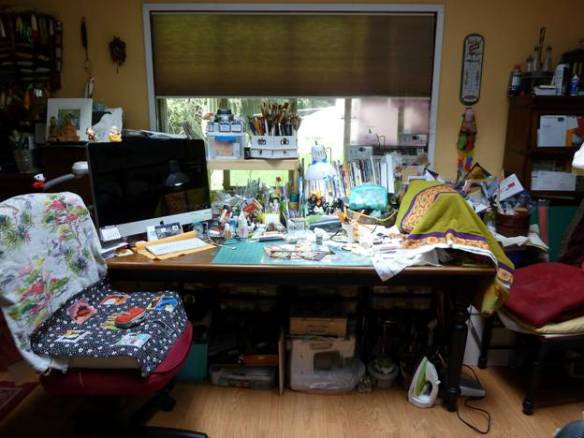
This large desk/table is my little creative spot. It’s well used and well loved. A sewing machine sits on the right end and my computer is on the left. I have storage underneath the table for many of my supplies. All of my wealth in fabric is “upstairs” – up the ladder.
To yourself, to friends and family?
I don’t really use the word ‘sewing room’ because I don’t only sew – it’s a studio room to me and I dream of having a real studio! Don’t we all?!
Why do you think this is so?
See answer above…. It’s so much more than just sewing!
Difference in starting point between quilting and art?
I began quilting in 1976! Before that I was a weaver and spinner (my uncle was pleased to point out that in German ‘spinner’ meant something like ‘crazy’! I loved making (and in the early years selling) bed quilts. To this day I love to make bed quilts and sleep under more traditional patterns.
I think that I made the transition to art quilts as a natural extension of my bed sized quilts. It was always a matter of thinking “what if?” Of course, thinking “what if?” is also what started me on the mixed media road too. In 2006, during a trip to Houston with my friend Sarah Smith, I distinctly recall saying (as we walked by a mixed media booth) that I “would never do mixed media.” How utterly foolish of me, because, since I made that statement, I have become immersed in mixed media and am thoroughly enjoying the ride! I feel that it all adds so much dimension that I can translate to mark making on cloth. It’s all one big circle to me!
Thinking of this as a business rather than a hobby?
I have made things to sell, but have never really had the time to think of it as a business. For me, time has always been an issue; time coupled with limited energy and my daily ‘pay for health insurance’ job! After June of this year though I will, most assuredly, be hoping to sell more of my work and I will be, once again, entering shows and contests.
What do you have in the room table? machines, supplies, fabrics, paints, etc. Anything that might surprise the rest of us?
I keep one of my sewing machine out on my table at all times. I keep my felting machine under the table and ready to go. I have my computer and many mixed media art supplies on my table – most within an easy reach. My threads are stored both “up the ladder” and on my work table in a dedicated case.
Under my table live four large organizers with four drawers each, There I keep my paints (acrylics & watercolor), papers, inks, markers, pencils, stamps, metal work supplies, embossing machine and all of “must have” tools. The books that I use the most are also kept on the table in a special book rack that a dear friend made especially for me.
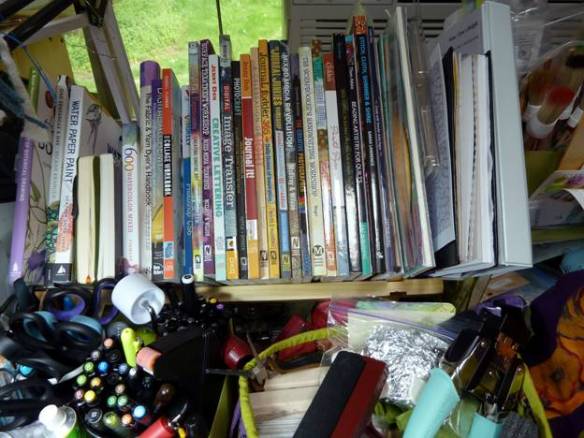
My best friend’s husband made this great little bookshelf for me – it was specially designed to fit the spot on the table. It holds the books that I am currently using the most. The contents sometimes vary but not too often. These books all provide a lot of creative energy for me.
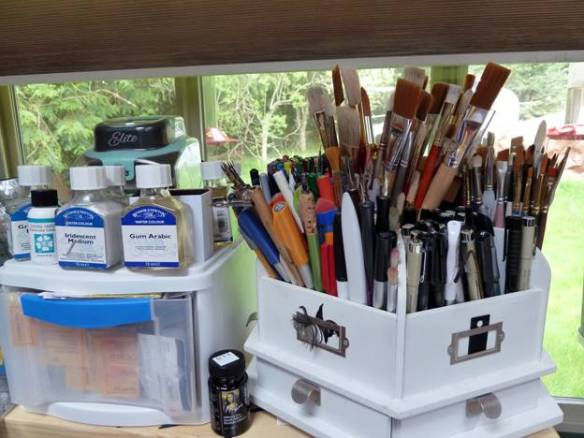
My dip pens, pencils, brushes and watercolor adjuncts all share a happy little space on another specially built little shelf. Everything is in easy reach!
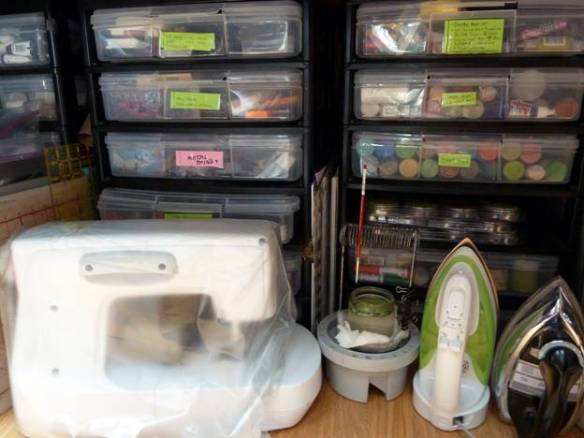
Here are the four matching storage containers that live underneath my “create-a-spot” table. They actually work rather well, keeping my things relatively organized and I can usually find what I am looking for – on a good day!
How is your “stuff” organized?
Organized is a relative term for at this point! I love to be organized, but that is very difficult for me to be right now. I can’t say that it does not make me crazy at times. I feel like I am “Gaslighting” myself sometimes!
How do you organize your fabric? By color? Amount? Any separate categories (batiks, hand dyes)?
I like to keep my fabrics sorted solids, batiks and prints and then, loosely, in color families; blue, red, yellow etc. Since I seem to use far more solids than prints these days, I find myself with far too many prints in my collection that are going unused. One of my priorities is to sort them all out and find somewhere that needs fabric donations! Anyone know of anywhere in the US that needs fabrics?!
How do you organize your thread (color, weight)?
I sort my thread my weight and then color.
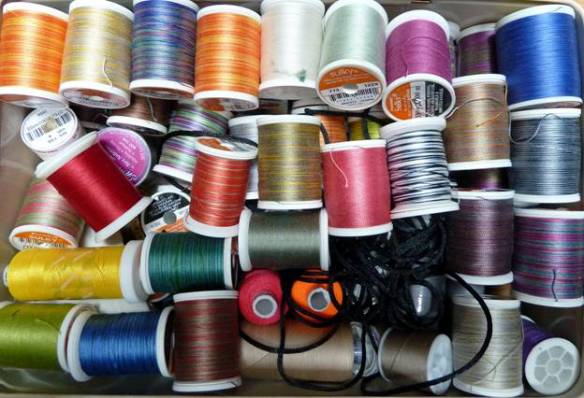
Most of my threads are stored “upstairs” with my fabrics, but I keep several containers of the threads that I use the most underneath my “create-a-spot” table. This one holds some of my stash of Sulky 12 wt which I am very fond of using – especially on my quifelted bags (QuiFelt = Felted bags that are free motion quilted)
Do you have anything, supplies, more machines, etc. tucked away in any other rooms of the house?
Oh! This question cracks me up! I think I have supplies of one sort or another in every room of the house. I don’t like it that way and hope to someday change it! I store my yarns and knitting things in a spare bedroom closet – along with fleece and spinnable products.
Other sewing machines (three Featherweight and some vintage Singers) are stored in various spots. I keep the Featherweights all in good working order and love using them for workshops!
How many other rooms?
ALL of them!
Has a family member or significant other ever accused you of “taking over” the entire house?
DH has never ‘accused me of it’ but I sure know that he thinks it!
If you have a separate building, we want lots of pictures.
Oh! How I wish, and if I did have a separate building or space I would delight in providing photos of it !
How much horizontal surface do you have, and is it ever enough?
I have very little horizontal space and yes, I DO have to move things when I need to cut large pieces of fabric. Many times, despite my back issues, I have to lay large cutting boards on the floor and cut fabric that way. Another of my dreams is to have a cutting area that is at a comfortable height to stand at. I know that my cutting would be FAR more accurate if I had that space!
Do you have to move piles of stuff to cut anything bigger than a fat quarter?
Well, larger than a half yard!
Do you straighten/organize as you go, putting each fabric away as you cut, or do you clean up after a project?
Because I have so little space I tend to clean up as I go along. Generally that will mean tidying up daily when I am working on something mixed media, or weekly for a larger sewing/quilt project.
It’s rather funny really because I hate to be cluttered and disorganized, but that is how my ‘studio table’ makes me be at the moment – so I just try to work as best I can and keep things as orderly as possible along the way. I ‘lose’ things with regularity though, because every time I tidy up I forget where I have stashed things! I find that I need to have a space and everything must be returned to that space in order to be able to find my tools easily and without much fuss. If I leave a technique alone for too long though I generally have to hunt and sift for a bit to locate the need items. Ugh! Of course, I think my life would be much easier if I could cut down on the number of things that I love to do.
I work with cloth, of course, but I also knit, paint, mono-print, felt, use photographic tools and, as I mentioned before, have fallen deeply engrossed I the “many tools” world of mixed media art! All of these passions add up to needing space, which is a real premium for me. The problem is that when I think about what I would might “give up” doing, and, thereby, give up needing space for– I can’t think of anything that I would want to NOT do!
How many projects do you work on at a time and how do you keep them organized?
I generally have one knitting project, one cloth project and one mixed media project going at a time. Knitting is generally relegated to the evening hours while sewing and mixed media is for during the day. Sometimes deadlines will dictate what and when I work on something. If I have a project for a company to do then I always make that a priority. Next up are my ATC and small art trades. I have realized that I really want to dedicate some more time to working on larger, multi media and cloth projects – so I anticipate that my priorities will shift just a bit in the near future
Anything more you want to add about your studio, organization, working methods, etc., please do.
I know a lot of people who have an idea first and then work based on their idea. I almost never have an idea until I start a project. Sometimes I think that I will never find the way to represent a theme, but then, once I actually begin by putting pen to paper or thread to cloth, the ideas begin to pop up. I’ve always wished that I could be one of those people who has a concept and works from it – but I seem to work the opposite way. There are times when I have a seed thought, but even if I start from that, the finished project is never the way I thought it would be. I seem to have to look at the paints, fabrics, threads or materials that I plan to use in order for the muse to chat with me! I find it fascinating how we all process art so differently, and also at how differently we all learn. I’ve always been sort of a hands on learner and artist. I wonder if these various preferences are something that we learn or are they something that we are each sort of hard-wired for?
Thank you Marie for letting us visit and for your thoughts on the various paths through the creative process.
To learn more about Marie, visit her website or book blog.
Next month: Jane Davila
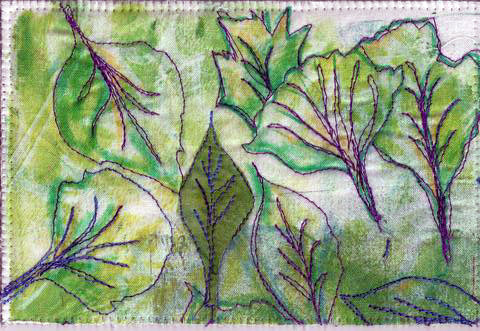 L is for Ludwig by Sarah Ann Smith
L is for Ludwig by Sarah Ann Smith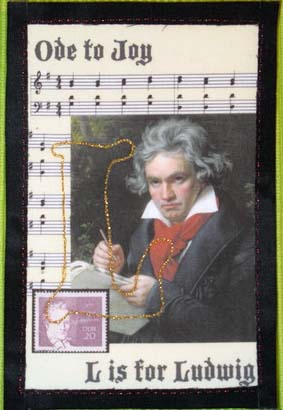 M is for Mandala by Diana Welte
M is for Mandala by Diana Welte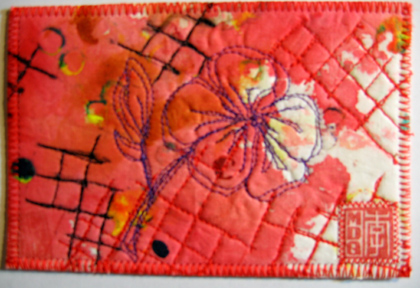 See earlier postings about the alphabet trades here, here, and here.
See earlier postings about the alphabet trades here, here, and here.
